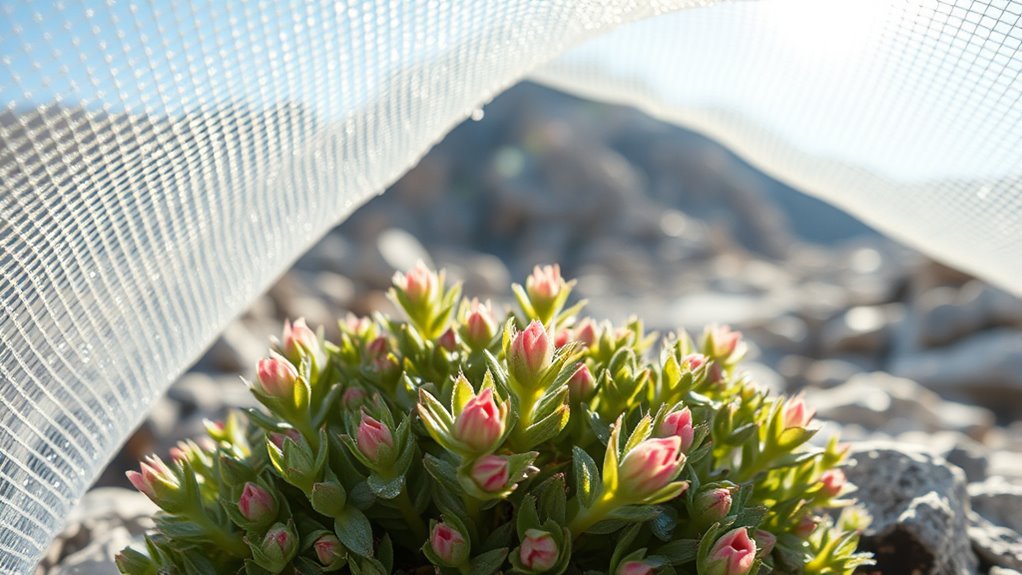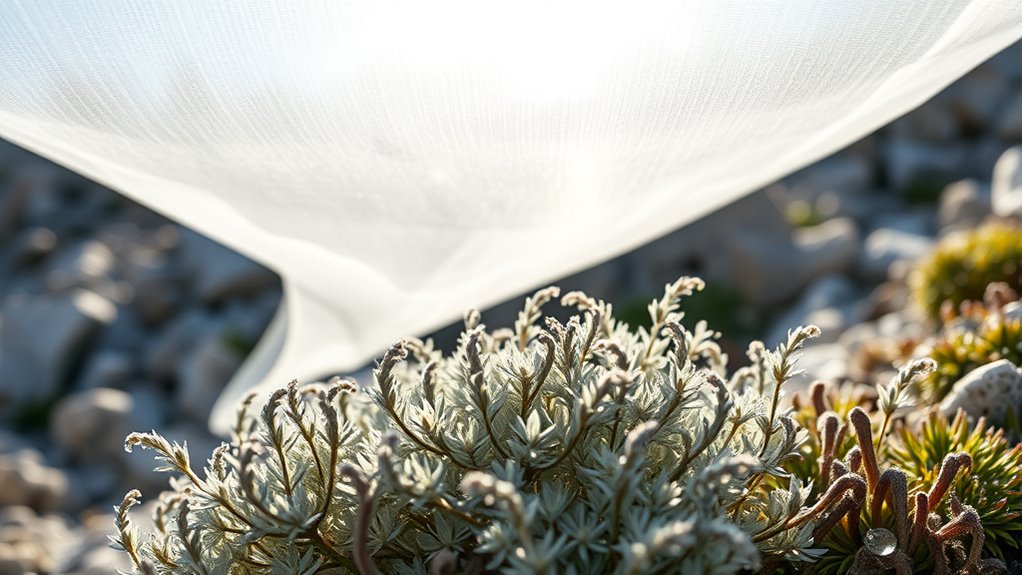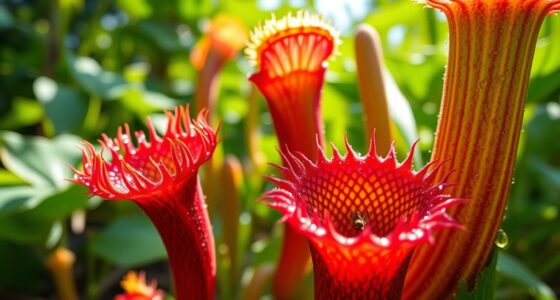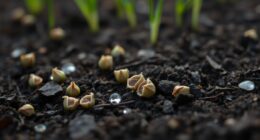To protect delicate alpine plants during hot summers, make certain you water deeply early in the day or late at night to keep soil moist. Use organic mulches like bark or gravel to insulate roots and reduce evaporation. Provide shade with shade cloths or by placing taller plants nearby, especially during peak heat hours. Adjust care routines based on weather and stay vigilant for signs of stress. Continue exploring these strategies to help your plants thrive despite the heat.
Key Takeaways
- Water early morning or late evening to minimize evaporation and keep soil consistently moist.
- Apply mulch like bark or gravel to insulate roots and reduce soil temperature fluctuations.
- Use shade cloths or position taller plants nearby to shield delicate alpine foliage from direct sunlight.
- Improve soil with organic matter for better moisture retention and aeration, preventing dehydration and root issues.
- Monitor plants regularly for stress signs and adjust watering and shading efforts during extreme heat.

During hot summer days, alpine plants can struggle to survive if they’re not properly protected from heat stress. These delicate plants are adapted to cooler mountain environments, so prolonged exposure to high temperatures can cause dehydration and damage. To give them the best chance of thriving, you need to pay close attention to watering schedules and soil health. Consistent watering is essential, but it’s equally important to avoid overwatering, which can lead to root rot. During peak heat, watering early in the morning or late in the evening ensures the plants receive adequate moisture without excessive evaporation. Deep, thorough watering encourages the roots to grow deeper, making them more resilient to temperature fluctuations. Adjust your watering frequency based on the weather—more during heatwaves, less during cooler spells—but always check the soil moisture level to prevent it from drying out or becoming waterlogged.
Water alpine plants early or late to prevent evaporation and promote deep root growth during hot summer days.
In addition to your watering routine, soil amendments play a vital role in protecting your alpine plants. These plants prefer well-draining soil with good aeration, so adding organic matter like compost or peat moss can improve soil structure and moisture retention without making it too dense. Mulching around the plants with gravel, bark, or other inorganic materials helps insulate the roots and keep the soil temperature stable. Mulch also reduces moisture evaporation, maintaining a more consistent environment for your plants. Be mindful to keep mulch a few inches away from the plant stems to prevent rot and fungal issues. Incorporating appropriate soil amendments can further enhance soil resilience against extreme heat.
Furthermore, consider shading your plants during the hottest parts of the day. Using shade cloths or strategically placing taller plants nearby can shield delicate foliage from direct sun exposure. This helps prevent leaf scorch and reduces water loss. Regularly monitor your plants for signs of stress, such as wilting or discolored leaves, and adjust your care routine accordingly. During extreme heat, providing additional watering and shade can make all the difference in keeping your alpine plants healthy and vibrant.
Ultimately, protecting alpine plants from heat stress requires a combination of strategic watering schedules, soil amendments, and environmental adjustments. By maintaining consistent moisture levels, improving soil quality, and shielding plants from intense sun, you help them withstand the summer heat. With attentive care, your alpine garden can flourish even during the hottest months, showcasing their beauty despite challenging conditions.
Frequently Asked Questions
How Can I Tell if My Alpine Plants Are Overheating?
You can tell if your alpine plants are overheating by looking for signs like leaf discoloration, which may turn yellow or brown, and wilting symptoms, where the leaves droop or feel limp. If you notice these changes, it’s a clear sign they’re stressed from heat. To prevent damage, guarantee they’re shaded during the hottest part of the day and keep the soil consistently moist, not waterlogged.
Are There Specific Mulch Types That Help Protect Alpine Plants?
You might wonder if certain mulch types protect your alpine plants better. Opt for mulch color options like light-colored or reflective mulches, which reflect heat and keep roots cooler. Organic mulches, such as pine bark or straw, improve soil moisture and insulation, while inorganic options like gravel or crushed stone prevent overheating. Choose based on your plants’ needs, ensuring they stay shaded and cool during hot summer days.
Can I Use Reflective Materials to Keep Plants Cool?
Sure, why not wrap your delicate alpine plants in shiny, reflective mulch or heat reflective fabrics? It’s like giving them a tiny mirror to deflect the sun’s fiery gaze. These materials bounce heat away, helping keep your plants cool during scorching summers. Just imagine them basking under reflective fabrics, feeling like royalty—cool, protected, and perhaps a bit shiny. It’s a clever trick for those who love a bit of sparkle in their garden!
How Often Should I Water Alpine Plants During a Heatwave?
During a heatwave, you should water your alpine plants more frequently, about every 2-3 days, to maintain consistent moisture. Alpine plants generally have low drought tolerance, so don’t wait too long between waterings. Keep an eye on soil moisture and adjust your watering frequency as needed. Proper watering helps prevent stress and keeps your delicate plants healthy despite the hot weather.
Do Alpine Plants Need Special Fertilizers During Hot Summers?
Oh, sure, alpine plants need a fancy summer cocktail of fertilizers, right? Actually, they don’t require special fertilizers during hot summers, just a gentle boost with balanced nutrients. You should focus on fertilizer adjustments based on their existing nutrient requirements, but overfeeding can harm them. Keep it simple—use a mild, slow-release fertilizer if needed, and watch them thrive without turning into a botanical experiment.
Conclusion
To keep your alpine plants thriving during hot summers, stay vigilant and provide extra shade or mulch when needed. Remember, a little effort now can save you from a lot of heartache later. Don’t wait until the heat wave hits—be proactive and give your delicate plants the protection they deserve. With some careful planning, you’ll ensure they stay healthy and flourish, proving that it’s better to be safe than sorry when it comes to your mountain treasures.










